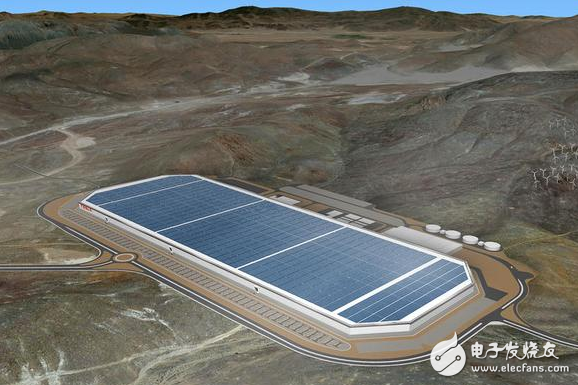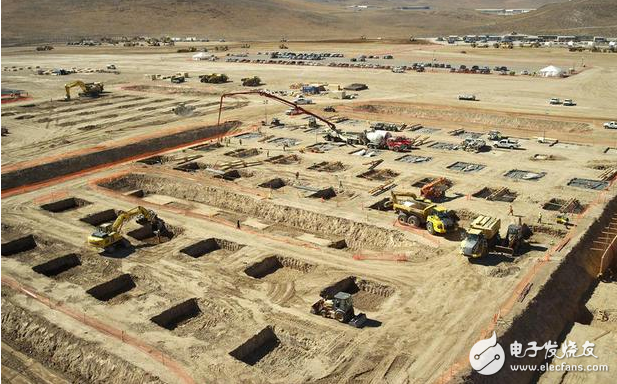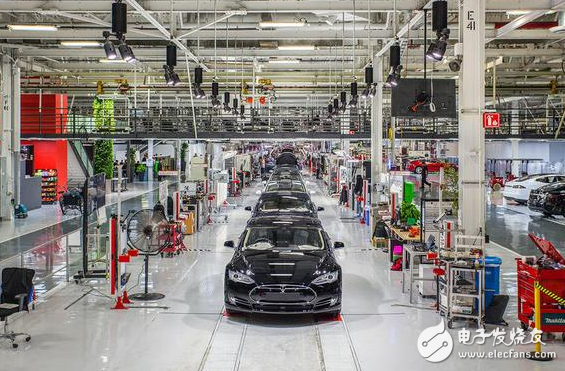Since the announcement of the Gigafactory plant project, Tesla has claimed that the plant will not use any fossil fuels in the future, but instead will use fossil fuels instead of renewable energy – relying mainly on solar arrays to provide energy.
Now, the company confirms that the Gigafactory plant will have rooftop solar arrays and ground-based solar facilities. Tesla said in an introduction to investors that the 70MW rooftop solar array will be the world's largest solar power installation.

Tesla said: "The first Gigafactory plant will be a manufacturing plant that does not use fossil fuels (natural gas or oil) and relies entirely on electrical energy. Through a 70MW rooftop solar array and solar floor facilities, we will be 100% The use of sustainable energy. The new rooftop solar array system has more than seven times the size of the world's largest solar array system.
Currently, the largest rooftop solar array in use in the United States is the regional distribution center from Whirlpool Corpora TIon, Calif., with a capacity of 10 MW. Another larger solar array comes from India with a capacity of 11.5 MW. For the 70MW capacity, both solar array facilities belong to the pediatrics.

Tesla also revealed specific details of its climate control system, water treatment system and battery recycling system at its Gigafactory plant:
Because the plant uses all of its electrical energy, it is more efficient and achieves the goal of zero carbon emissions. The waste heat recovered during the production process can meet the heating requirements of most buildings. The closed-circuit water circulation system at the Gigafactory plant uses six different high-efficiency circulating water treatment systems that provide approximately 1.5 million liters of water per hour. Compared to standard water treatment processes, the new system reduces the use of new water by nearly 80%. The battery recycling system currently under construction at the construction site will be able to safely recycle all types of waste batteries, battery modules and battery packs of Tesla in the future, and the recovered metals can continue to be used in the manufacture of new batteries."
In the documents provided to investors, Tesla detailed the production process of battery products. It is also disclosed that a company from Germany has also been in the Gigafactory factory and is engaged in the manufacture of battery casing products.
Interestingly, Tesla apparently “stopped†the introduction of the “Model 3 electric vehicle battery pack†in the documents provided during the investor's reference period.
It is unclear what details investors have seen during this visit, but Tesla is likely to show them for the first time the battery packs used in their upcoming Model 3 electric vehicles. It is not clear at this time whether Tesla's battery pack is used for its energy storage products Powerwall or Powerpack.

Last week, the electric vehicle manufacturer confirmed to the outside world that it plans to start producing the battery packs needed for the Model 3 electric car in the second quarter of 2017.
According to Tesla's original plan, the battery capacity of the first Gigafactory plant will reach 35GWh, and the capacity of the battery pack will reach 50 GWh. But the company is now adjusting its initial capacity targets and plans to reach the above capacity in 2018. In addition, it is planned to increase the overall capacity of the Gigafactory plant to more than three times its current target by around 2020.
In the documents provided to investors, Tesla explained how it succeeded in reducing the investment cost per GWh unit of the Gigafactory plant and how to achieve growth:
1. Increase the production density of production facilities and accelerate production capacity;
2. Interior design and construction methods;
3. Complete and comprehensive facility system, equipment design, layout and implementation method;
4. Innovative building construction technology can effectively reduce land occupation area, building and infrastructure area, as well as construction materials and labor costs.
Tesla also offers the following measures for the reduction in production costs per kWh of battery and battery pack:
1. Coordinate the production methods to reduce the amount of taxation and input costs (raw materials, components, labor, energy and water);
2. Re-engineering all supply chains to achieve higher efficiency capacity scales and tailored component needs while reducing transportation costs;
3. Improve the design content of the battery product, improve the battery energy density level, and optimize the battery size (2170 vs 18650);
4. Improve the battery module and battery pack design content, and improve the energy density level of the battery pack;
5. Improve automation and process design content to increase production. Reduce the cost of waste and improve on-site reliability;
6. Reduce the capital invested per GWh of production capacity and reduce the depreciation expense.
At present, the Model 3 electric vehicle is priced at US$35,000 in the US, but for the UK market, this electric vehicle arrives in the UK and needs to consider the corresponding import and export costs, so its cost price may be close to 35,000 US dollars. From the current point of view, the Gigafactory plant is a key factor in helping Tesla to further reduce cost prices.
Here are the key figures behind the new Tesla plant:
35 GWh (35,000 MWh) capacityThe original planned annual production capacity of Tesla's new plant is based on gigawatt-hours. After reaching the standard, the production capacity can reach 35 GWh (35,000 MWh). Therefore, a GWh unit is equivalent to a battery capacity capable of generating 1 billion watts. As a result, the new plant will eventually be able to supply lithium-ion batteries to 460,000 Model S electric vehicles each year.
2020 goalTesla hopes that the new plant will achieve full production in 2020, and the annual production of lithium-ion batteries in the new plant will exceed the total global lithium-ion battery production in 2013. Tesla will achieve this goal in its 17th year of its establishment.
Annual production of 500,000 electric vehiclesIn the end, Tesla hopes that the plant will produce 500,000 electric vehicles a year. For this electric vehicle manufacturer, this is undoubtedly a revolutionary change, because the ability to produce 500,000 electric vehicles a year has made it impossible. From a long-term perspective, Nissan's plant in Sunderland is one of the largest electric vehicle production plants in Europe. Since its establishment in 1984, the plant has achieved 28 million production per year after 28 years of hard work.
Covers an area of ​​3,000 acres (about 12 square kilometers)The new 9000-acre (N12-square-kilometer) plant in Nevada will be one of the largest buildings in the world after its official completion. The buildings currently completed in the factory cover only one-sixth of the total planned floor area.
6,500 employeesThe new facility will employ nearly 6,500 people by 2020. At present, the number of people who participate in the construction on site is more than double that of the original plan. In order to complete the construction target as soon as possible, 1,000 construction workers are working overtime in accordance with the two-shift operation of 7 days a week.
Predetermined amount of 400,000 electric vehiclesTesla's new electric car Model 3 has proven to be a popular Volkswagen electric car. This is part of the reason that Elon Musk is eager to get the gigafactory factory up and running as soon as possible. The number of electric cars for the general consumer market has reached 400,000, and Tesla plans to officially deliver these scheduled vehicles by the end of 2017.
$5 billion in investmentIt is reported that the total investment of this factory is close to 5 billion US dollars (about 3.8 billion pounds), and the funds are mainly from Tesla and many companies with which it has cooperation, including Panasonic Battery Company.
Dash Cam For Vw,Parking Mode Dash Cam,Vw Universal Traffic Recorder,4K Dashcam Front And Rear
SHENZHEN ROSOTO TECHNOLOGY CO., LTD. , https://www.rdtkdashcam.com